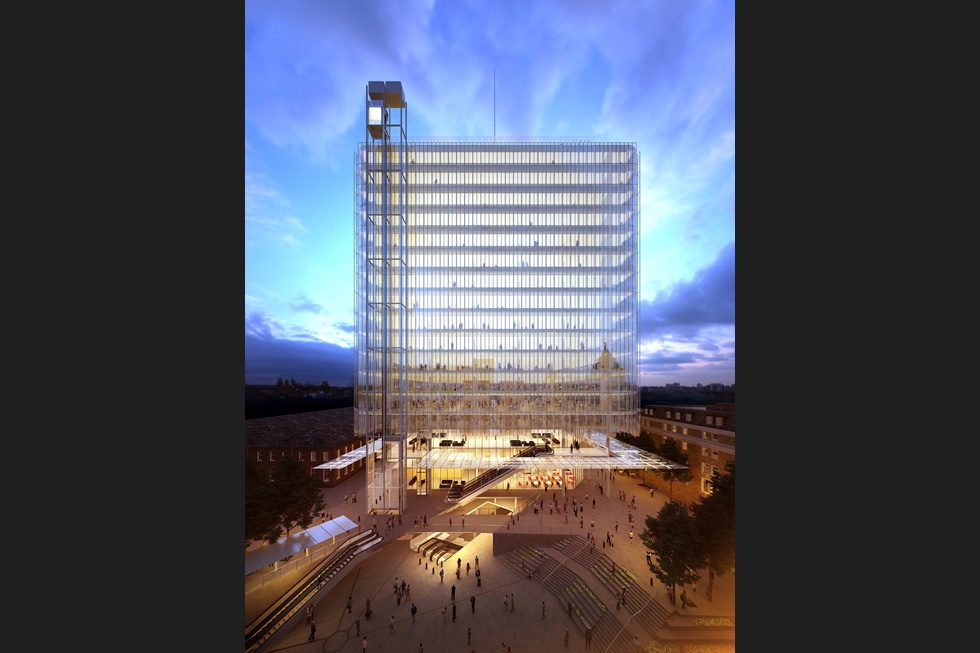
Communities secretary Sajid Javid has given the green light to Renzo Piano’s controversial £775m Paddington Cube, according to the AJ’s sister title Construction News
Javid last month issued an ‘Article 31 direction’ to examine whether the Sellar Property Group backed project in west London should be called in for a public enquiry.
However, a Department for Communities and Local Government (DCLG) spokesman told Construction News today that ministers had ’decided not to call this development in’.
The 54m x 54m x 54m perfect cube is planned to house 33,445m² of offices, shops and restaurants above 0.5ha of newly created public realm, including a piazza and pedestrian links to public transport.
Conservation groups had called on Javid to launch a public inquiry into the 14-storey development, which is raised 12m above a public space, as it will replace a 110-year-old former Royal Mail sorting office.
A petition on the issue has attracted more than 1,300 signatures.
Westminster City Council granted planning permission to the project last December, but formal permission was held up by Mr Javid’s intervention.
The DCLG spokesman confirmed that the council is now free to issue a final decision on the project. The department did not provide any more information on the decision.
Westminster City Council’s cabinet member for planning and public realm Daniel Astaire told Construction News: ’The council welcomes the decision from the secretary of state not to call in this planning application and is pleased to hear government is content for the application to be determined by the city council.
’The committee members considered the scheme’s impact very carefully, but concluded the substantial social, economic and regeneration benefits coupled with the substantial public benefits outweighs the less-than-substantial harm to the heritage assets.’
Sellar Property Group is developing the scheme in partnership with Great Western Developments.
The 14-storey office block scheme replaced an earlier concept featuring a 72-storey skyscraper nicknamed the Paddington Pole. That proposal was was ditched last January following criticism from architects, Westminster Council, residents and campaigners concerned about its effect on the capital’s skyline.
Both SAVE and Historic England, the government’s statutory adviser on the historic environment, remain unhappy with the revised proposals.
SAVE accused Westminster Council’s former cabinet member for the built environment Robert Davis of presenting the scheme to other committee members in a ‘partisan one-sided manner’.
The group claims that Davis, who left his role as chair of the planning committee last month after nearly 17 years, disregarded ‘significant objections’ and noted how he had previously voiced his support for the scheme in the media.
During an interview with the AJ in September, Davis praised the building and said it would make Paddington ’the coolest place in London’.
SAVE added that his support for the scheme showed Davis had ‘predetermined his position and should not have taken part in deciding this application’.
SAVE director Henrietta Billings said: ‘We remain very concerned about its impact on the historic streetscape, and the way the proposals were handled before and during the planning committee discussions.
‘The abrupt departure of [planning] committee chairman Robert Davis following recent calls for a review of his involvement, adds weight to our view that this scheme needs robust and independent scrutiny through a public inquiry.’
She added: ‘Conservation areas are all about celebrating and protecting special and recognised townscapes with important buildings and history.
‘The Paddington Cube throws the whole question of this protection into disarray. What is the use of conservation areas if mega-blocks like this, next to Grade I-listed buildings, can be nodded through planning committees?’
Barbara Weiss, co-founder of the Skyline Campaign, told the AJ that the building was ‘still incredibly tall in relation to the existing context, and would be very harmful to the character of the surrounding conservation areas’.
She added: ‘From a design perspective, the Cube still comes across as a “greedy” solution; too big for its site, and of no great architectural merit or finesse. The much-vaunted new public realm – the carrot that is constantly brought up as the main benefit to locals – lacks vision.
